I think a safe method would be to measure the distance between the bottom of the lowest woofer to the top of the highest radiating surface. If the top is a horn, it should be measured there. Use 1X that distance away to do the MMM, and start with an N pattern starting 30° to the left of center ending at 30° to the right of center.Next time I'll bring measurements from big horns (2 m).
It would be nice to know what and where to measure,so suggestions would be appreciated.
-
WANTED: Happy members who like to discuss audio and other topics related to our interest. Desire to learn and share knowledge of science required. There are many reviews of audio hardware and expert members to help answer your questions. Click here to have your audio equipment measured for free!
You are using an out of date browser. It may not display this or other websites correctly.
You should upgrade or use an alternative browser.
You should upgrade or use an alternative browser.
MMM approach and a new calibration app (magic beans)
- Thread starter PHD
- Start date
Thanks. I encourage you to do some listening tests. If you can get maybe 10 or 15 people, and set up a double blind test, and show that the method gives improved subjective performance, that would help make your case.What an honor to have you chime in!
For the subs, we use an average of the room response from the other speakers as a target response for the subs. The idea is to augment the sound while retaining the natural tonality of the speakers played in that room (room effects included.)
For the mid/highs, we do aim to get something like a listening window response. For that ideal speaker, the measurement at the MLP and the "room transfer function" or room response would be nearly identical which means that the difference between the two would lead to a flat line, meaning no need for correction to that ideal speaker. I agree 100% that a flat response at MLP is not what we want.
Will do. I have confidence that the method is correct. I had plans on competing in a shootout where I would put my method up against the popular room correction software. I wanted people to vote on the one they thought did the best job. The people throwing the event didn't like the idea that it might make the others look bad and offend the companies. I told them I had an equal chance of looking bad. They said no.Thanks. I encourage you to do some listening tests. If you can get maybe 10 or 15 people, and set up a double blind test, and show that the method gives improved subjective performance, that would help make your case.
I plan on doing some controlled testing. Brent Butterworth also recommended I do that to gain some legitimacy. I want to ensure it's done properly, so I'll probably need some advice about possible pitfalls. i.e. listeners not being acclimated to the room. I remember Paul Barton saying when they did blind listening tests at the NRCC, they had to throw out the first round of testing because it was so far off. When the listeners came back from a break, they would often think that a new set of speakers had been put into place even though nothing had changed.
- Joined
- Feb 23, 2016
- Messages
- 20,784
- Likes
- 37,679
So is it your hypothesis that MMM in the nearfield gives the same response as a Klippel or anechoic response for direct on axis? I think you've mentioned this, but trying to clarify what you think is happening. I'll even get around to doing my measures in time.
I do not think a NF MMM is equivalent to an anechoic on-axis response. I think a NF MMM is somewhere between a listening window measurement and an early reflections measurement depending on how far back the measurement needs to be and how much room interaction there is.So is it your hypothesis that MMM in the nearfield gives the same response as a Klippel or anechoic response for direct on axis? I think you've mentioned this, but trying to clarify what you think is happening. I'll even get around to doing my measures in time.
I think part of what's interesting here is the hypothesis that, if I've got this right, that the NF MMM, which includes diffraction/reflections from nearby surfaces, should be flattened. That seems to be what's really setting the MB method apart from what other correction schemes do, since none of them do any NF measurements.
It flattens NF to a certain extent. There might be instances where it doesn't try to flatten the NF response. I'll have to do more testing to specifically when it does/doesn't.I think part of what's interesting here is the hypothesis that, if I've got this right, that the NF MMM, which includes diffraction/reflections from nearby surfaces, should be flattened. That seems to be what's really setting the MB method apart from what other correction schemes do, since none of them do any NF measurements.
ernestcarl
Major Contributor
MMM result of the diminutive Fluid FX50 coaxial speaker (centered on top of my front desk's computer screen) across different in-room listening locations:
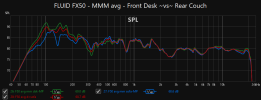
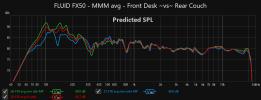
SPL of all curves were auto-aligned with the ff. settings:

Speaker EQ was devised using Amir's measurement data of this speaker and my own listening judgment (room EQ in that post was meant for another listening position):

*However, I decided to discard the last 9 kHz PEQ
There isn't much of a difference going very nearfield vs my front desk's MLP since the change in distance is rather small.
Desk MLP distance from the speaker is ~0.7 meter while couch MLP ranges from2.3 *2.8 to 3 meters (averaged across the entire length of the couch).
Normally, there would be more variation seen in the bass response and transition zone across the room listening areas or seats if the measurement region is limited (or not averaged) -- more so if not using MMM and instead only single-point measurements:

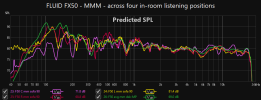
*In this one particular case, a manually adjustable general low shelf filter for the bass is probably sufficient -- Yeah, I'm just lazy! This speaker is not to be installed permanently here, anyway.


SPL of all curves were auto-aligned with the ff. settings:
Speaker EQ was devised using Amir's measurement data of this speaker and my own listening judgment (room EQ in that post was meant for another listening position):
*However, I decided to discard the last 9 kHz PEQ
There isn't much of a difference going very nearfield vs my front desk's MLP since the change in distance is rather small.
Desk MLP distance from the speaker is ~0.7 meter while couch MLP ranges from
Normally, there would be more variation seen in the bass response and transition zone across the room listening areas or seats if the measurement region is limited (or not averaged) -- more so if not using MMM and instead only single-point measurements:


*In this one particular case, a manually adjustable general low shelf filter for the bass is probably sufficient -- Yeah, I'm just lazy! This speaker is not to be installed permanently here, anyway.
Attachments
Last edited:
Can you take a NF MMM while it's at the couch position? What is the 0 and 90? The mic calibrations?MMM result of the diminutive Fluid FX50 coaxial speaker (centered on top of my front desk's computer screen) across different in-room listening locations:
View attachment 339235 View attachment 339236
SPL of all curves were auto-aligned with the ff. settings:
View attachment 339240
Speaker EQ was devised using Amir's measurement data of this speaker and my own listening judgment (room EQ in that post was meant for another listening position):
View attachment 339237
*However, I decided to discard the last 9 kHz PEQ
There isn't much of a difference going very nearfield vs my front desk's MLP since the change in distance is rather small.
Desk MLP distance from the speaker is ~0.7 meter while couch MLP ranges from 2.3 to 3 meters (averaged across the entire length of the couch).
Normally, there would be more variation seen in the bass response and transition zone across the room listening areas or seats if the measurement region is limited (or not averaged) -- more so if not using MMM and instead only single-point measurements:
View attachment 339238 View attachment 339239
*In this one particular case, a manually adjustable general low shelf filter for the bass is probably sufficient -- Yeah, I'm just lazy! This speaker is not to be installed permanently here, anyway.
ernestcarl
Major Contributor
Can you take a NF MMM while it's at the couch position? What is the 0 and 90? The mic calibrations?
The speaker remained in the same position (above the desk computer screen) all throughout, and the first measurement curve inside the mdat set is already the nearfield MMM: F50 mm desk NF 0 -- or, do you mean to say I have move the speaker closer to the rear wall of the room where the couch is located?
Pictures of the "temporary" setup may make things more clear:
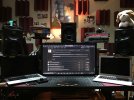
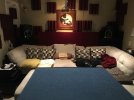
Oh, and the 0 and 90 (degrees) refer to the UMIK-1 calibration. Though, I do not keep the measurement microphone pointed straight up (for the 90) but rotate as well my wrist a little bit to take in some more random incidence energy.
dasdoing
Major Contributor
If an anechoic perfect speaker sounds better in a room than a speaker corrected to an in-room measurement what is happening?
a) in-room measurement is useless since it measures wrongly. a speaker in an anechoic chamber sounds the same as in-room
or
b) the interpretation of the in-room measurement is wrong
sorry, but a) makes no sense
a) in-room measurement is useless since it measures wrongly. a speaker in an anechoic chamber sounds the same as in-room
or
b) the interpretation of the in-room measurement is wrong
sorry, but a) makes no sense
That's helpful. It's interesting that the high frequencies don't drop off much at your sofa.The speaker remained in the same position (above the desk computer screen) all throughout, and the first measurement curve inside the mdat set is already the nearfield MMM: F50 mm desk NF 0 -- or, do you mean to say I have move the speaker closer to the rear wall of the room where the couch is located?
Pictures of the "temporary" setup may make things more clear:
View attachment 339252 View attachment 339253
Oh, and the 0 and 90 (degrees) refer to the UMIK-1 calibration. Though, I do not keep the measurement microphone pointed straight up (for the 90) but rotate as well my wrist a little bit to take in some more random incidence energy.
If you take a speaker that measures perfectly in an anechoic environment, and place it in a typical place, then the estimated in room response will likely match the response at the MLP. But what happens if you put that same speaker in a corner? It will have more bass from boundary gain. Do you propose not fixing those issues? I think they should. If that speaker is placed behind an acoustic transparent screen, and it changes the high frequency response, I think it should be adjusted for.If an anechoic perfect speaker sounds better in a room than a speaker corrected to an in-room measurement what is happening?
a) in-room measurement is useless since it measures wrongly. a speaker in an anechoic chamber sounds the same as in-room
or
b) the interpretation of the in-room measurement is wrong
sorry, but a) makes no sense
I'm open to a discussion on this.
Last edited:
@ernestcarl I've made some custom EQ for you if you would like to test it. PM.
ernestcarl
Major Contributor
That's helpful. It's interesting that the high frequencies don't drop off much at your sofa.
Ah... maybe not as much as expected, but some of that is illusory due to the arbitrary use of the "forced" SPL auto alignment centered at 1.2 kHz. The overall SPL does drop off though with distance and the further off-axis one goes.
ernestcarl
Major Contributor
@ernestcarl I've made some custom EQ for you if you would like to test it. PM.
Thanks. Will get back to you on that one.
Similar threads
- Replies
- 0
- Views
- 271
- Replies
- 10
- Views
- 612
- Replies
- 23
- Views
- 2K
- Replies
- 36
- Views
- 4K
- Replies
- 5
- Views
- 722
